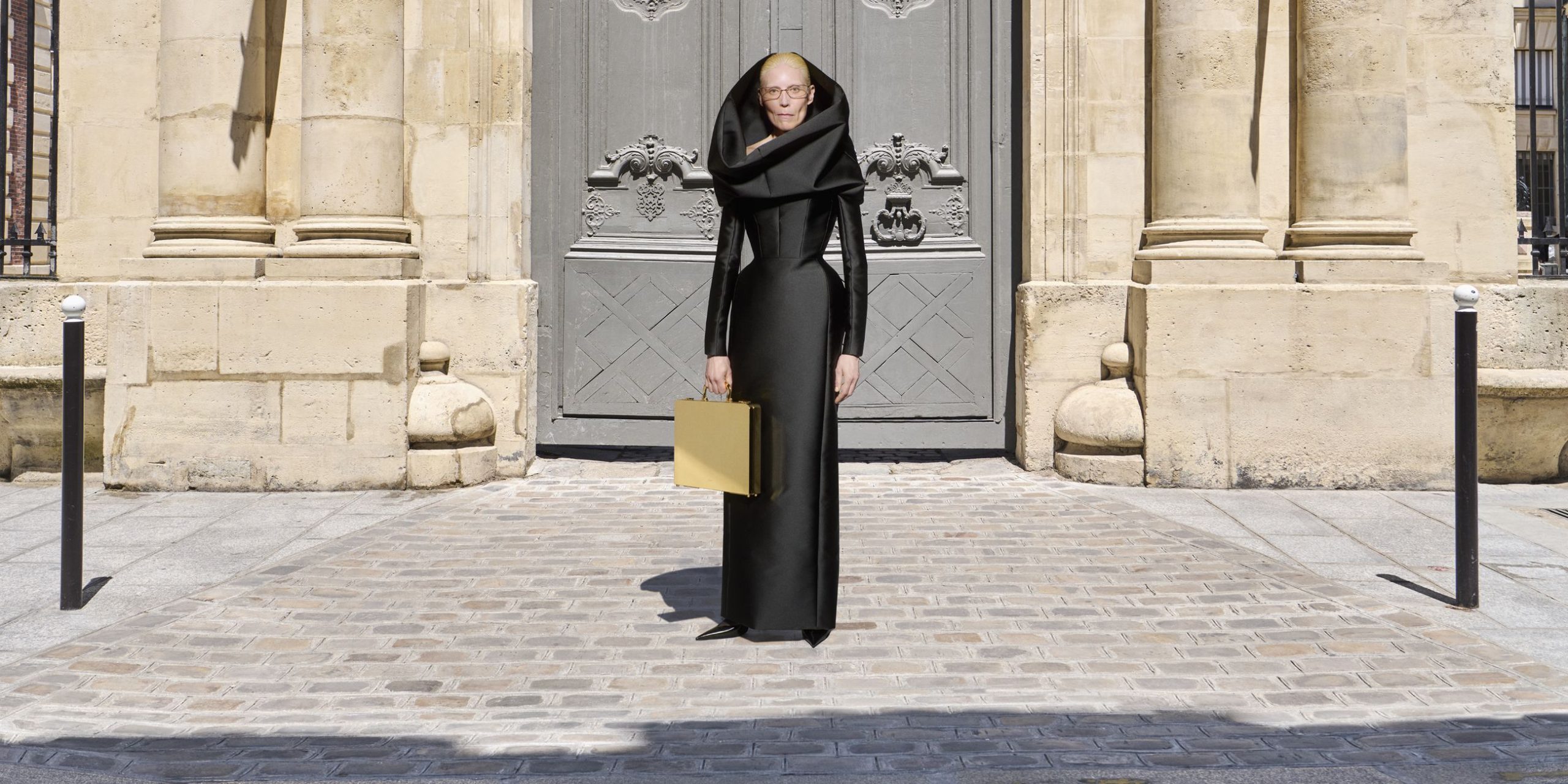Contents
Summary
Balenciaga is a cult luxury fashion brand celebrated for its innovative designs, bold silhouettes, and avant-garde approach to fashion. Founded in 1917 by Spanish designer Cristóbal Balenciaga, the luxury fashion brand is recognised for combining artistic expression with functional design. Pushing the boundaries of traditional fashion, its popularity graph is, once again, rising due to a marked emphasis on postmodern irreverence.
History
Balenciaga was established in 1917 in San Sebastián, Spain, by Cristóbal Balenciaga, a self-taught designer who earned acclaim for his impeccable craftsmanship and cutting-edge aesthetics. After the Spanish Civil War forced him to close his stores in Spain, Balenciaga relocated to Paris in 1937, where he opened his first couture house. His debut collection immediately garnered critical acclaim, with fashion editors hailing him as “The Master of Haute Couture.”
During the 1940s and 1950s, Balenciaga gained a reputation for his revolutionary silhouettes, such as the balloon jacket, tunic dress, and the high-waisted baby doll dress. His designs were worn by royalty and prominent figures, including Queen Fabiola of Belgium and socialite Mona von Bismarck. These years solidified Balenciaga’s legacy as one of the greatest designers of the 20th century.

Per Vogue, “The woman who owns a single Balenciaga, the woman who has never owned an original—both have been converted to the enduring greatness of The Idea. The informed cutting, the superb construction inside and out. The colors of the bull ring… [Cristobal Balenciaga’s] serene loyalty to established themes with the subtlest variations. The use of tonality… [He] combines with drama—for which he has a Spaniard’s quick sensitivity—a worldly sense of discretion. His high standards have created a new level of excellence that reaches everyone.”
In 1968, Cristóbal Balenciaga retired, marking the end of an era. After his departure, the brand went through a period of dormancy until its revival in 1986 when the house was acquired by Jacques Bogart S.A. The appointment of Nicolas Ghesquière as creative director in 1997 revitalised Balenciaga, with his futuristic designs. Per BoF: “Ghesquière spent a total of 15 years at Balenciaga, a once ailing womenswear house which he transformed into one of the most forward-thinking luxury brands in the world (and the most exclusive and sought-after ticket at Paris Fashion Week) with his complex vision, sculptural tailoring and use of ultra-modern fabrics.”
In 2001, the Kering Group acquired Balenciaga, further cementing its position as a leader in the luxury fashion industry. Demna Gvasalia took over as creative director in 2015, ushering in a new era of innovation with designs that challenged convention and resonated with younger, trend-focused audiences. Under Gvasalia’s direction, Balenciaga has become a pioneer in combining streetwear with high fashion, introducing oversized tailoring, sneaker culture, and politically charged statements into its collections.
Demna understands how Generation Z is thinking — and where he can take it from there. Last year, Balenciaga and Epic Games announced a collaboration to bring the brand’s apparel into the world of video games. Fortnite characters are now clad in looks from Balenciaga’s latest collections. Interestingly, the partnership has physical manifestations, including a fashion campaign and a line of merchandise. Shortly after, Demna Gvasalia struck again. While presenting Balenciaga spring-summer 2022 at Paris Fashion Week, he dropped a never-before-seen episode of The Simpsons, with characters Marge, Homer, Bart, Lisa and the rest of the cast wearing the newest looks.
Per GQ, “this mix of genres and cultures is an integral part of Balenciaga’s winning strategy. Indeed, the brand has understood that Gen Z — the new prime target for luxury houses — wants neither pigeonholes nor stereotypes. The success of the brand at the last MET Gala shows that Balenciaga is all over the red carpet. And that’s not to mention Balenciaga’s collab with the same Kanye ”Ye” West during the release of ‘Donda.’ These gambles may seem crazy at first glance, but they’re winning on all fronts, since the luxury house has evidently never been so popular…”
That’s not all. The French luxury brand has the memo on sustainability. Balenciaga Spring Summer 2021 was environmentally friendly due to its focus on up-cycling and repurposing. For Demna, it seems that “fostering the values of sustainability is a two-pronged affair—and streetwear is his chosen medium,” writes Weiqi Yap in Vogue. “As sustainability increasingly finds its way into more designer collections, clothes designed with the planet in mind no longer have a singular aesthetic. And for Balenciaga, they look a lot like a playful disregard for the gender binary, and old-school pieces that stand the test of time.”

Balenciaga Creative Director Demna was named a Chevalier of the Ordre des Arts et des Lettres, recognising his impact on fashion and culture, in 2025. The award was presented by France Minister of Culture, Rachida Dati. This recognition places Demna alongside recent honourees such as Simon Porte Jacquemus and Dior Men’s Kim Jones. The Order of Arts and Letters has also been awarded to Iris Van Herpen, Giambattista Valli, Simon Porte Jacquemus and the late fashion editor André Leon Talley.
Kering announced the appointment of Pierpaolo Piccioli as the new Creative Director of Balenciaga, effective July 10, 2025. He succeeds Georgian designer Demna, who was recognised for his dystopian design aesthetic, luxury sneakers and drop-shoulder hoodies. At Balenciaga, Piccioli builds on the strengths and success achieved by the brand under Demna’s creative direction, and in continuity with the legacy of founder Cristóbal Balenciaga. “Balenciaga is what it is today thanks to all the people who have paved the way. In all its phases, while constantly evolving and changing, it has never lost track of the House’s aesthetic values. What I am receiving is a brand full of possibilities that is incredibly fascinating,” he says.
“I’m excited to begin this new era at Balenciaga with Pierpaolo. His creative vision will thrive, and he will perfectly interpret the legacy of Cristóbal Balenciaga, building on the House’s bold creativity, rich heritage and strong culture,” added Balenciaga CEO Gianfranco Gianangeli. “With the expertise of our teams and the dynamic creative energy that has historically driven Balenciaga, I look forward to what we will build together.”
Vision
Balenciaga envisions a future where fashion becomes a dynamic and transformative medium for self-expression, cultural dialogue, and innovation. By constantly redefining the boundaries of traditional luxury, the brand seeks to challenge the status quo, offering designs that provoke thought, inspire creativity, and encourage individuality. Balenciaga’s vision is rooted in the belief that clothing is not merely a functional necessity but a powerful tool for storytelling that reflects society’s values and aspirations.
At the heart of Balenciaga’s vision lies its commitment to sustainability and social responsibility. The brand aims to lead the fashion industry toward a greener future by prioritizing eco-conscious practices, such as using renewable resources, upcycled materials, and innovative production techniques that minimize waste. Balenciaga also strives to promote inclusivity and ethical transparency, ensuring that its collections resonate with a diverse audience while adhering to the highest standards of integrity. This forward-thinking approach positions Balenciaga as a beacon for positive change in an industry often criticized for its environmental and social impact.
Balenciaga’s vision extends beyond design and production, encompassing a broader cultural perspective that embraces technology and new media. By leveraging digital innovation, the brand seeks to revolutionize the customer experience, creating immersive and interactive platforms that engage audiences worldwide. This seamless integration of artistry, technology, and sustainability reflects Balenciaga’s ambition to remain at the forefront of global fashion, not only as a leader in luxury but as a catalyst for transformative change in the way we perceive and engage with fashion.
Mission Statement
Balenciaga’s mission is to push the boundaries of creativity and challenge traditional notions of luxury through groundbreaking design and innovative thinking. The brand is committed to crafting high-quality products that celebrate individuality and artistic freedom while fostering inclusivity and sustainability. To achieve this, Balenciaga emphasizes the use of ethical practices, eco-conscious materials, and a transparent supply chain. By continuously adapting to the evolving needs of its audience, the brand seeks to create an enduring legacy that resonates across cultures and generations.
Products And Services
Balenciaga offers a wide assortment of luxury products, including ready-to-wear, footwear, handbags, and accessories. Known for its innovative designs, the brand’s collections often have bold statement pieces, such as the Triple S sneakers, oversized coats, and asymmetrical dresses. The introduction of streetwear-inspired apparel has also attracted a younger demographic, while maintaining the brand’s luxury appeal. Balenciaga also provides bespoke services, including made-to-measure garments and personal styling consultations. Its commitment to sustainability has also led to the development of eco-friendly initiatives, such as using upcycled materials and reducing waste across its operations.
Awards and Recognition
Over the years, Balenciaga has received numerous accolades for its contributions to the fashion industry. Under the creative direction of Demna Gvasalia, the brand has won awards such as the “International Designer of the Year” at the CFDA Fashion Awards in 2017. The same year, Gvasalia was also named among TIME magazine’s 100 most influential people, further cementing Balenciaga’s cultural impact. Balenciaga’s legacy as a pioneering fashion house is further evidenced by its presence in major museums and exhibitions. The Victoria and Albert Museum in London and the Musée des Arts Décoratifs in Paris have both hosted retrospectives celebrating Cristóbal Balenciaga’s revolutionary designs and enduring influence on the fashion world.
Key Team
- Cédric Charbit – Chief Executive Officer
- Demna Gvasalia – Creative Director
- Jean-François Palus – Kering Group Representative
- Charlotte Meyer – Chief Financial Officer
- Ludivine Pont – Chief Marketing Officer
References
- “Balenciaga”. The American Heritage Dictionary of the English Language HarperCollins.
- “What is the State of Luxury’s Hundred Million Dollar Licensing Deals?”. The Fashion Law.
- “Kering Names New CEOs at Saint Laurent and Balenciaga”. Business of Fashion.
- “Cristobal Balenciaga (1895-1972)”. Timeline of Art History. Metropolitan Museum of Art.
- “Cristóbal Balenciaga”. Victoria & Albert Museum.
- “In Which Cristobal Balenciaga and Christian Dior Bring A New Dawn”. This Recording.
- “5 Famous Fashion Designers Ties To The Nazis”. The Fashion Spot.
- “Cut Against The Bias”. This Recording.
- Pretty in pink: Jacqueline Kennedy and the politics of fashion. New York
- “Nicolas Ghesquiere, a Creative Young Spirit in the Master Class, Balenciaga: Reviving and Revering”. International Herald Tribune.
- “Is Copying Really a Part of the Creative Process?”. The New York Times.
- “Barco – Barco MiPIX and LED displays chosen for exclusive Kylie concert”. barco.com
- “Celebrity Dress”. Thecelebritydress.com.
- “Raquel Zimmerman in vintage Balenciaga”. slide.com.
- “Tatiana Sorokko’s Extending the Runway”. San Francisco Chronicle.
- “A Spanish Night for Balenciaga in San Francisco”. Women’s Wear Daily.
- “Nicolas Ghesquière to Leave Balenciaga”. The New York Times.
- “Balenciaga RTW Fall 2014”. WWD.
- “Balenciaga, Nicolas Ghesquière Trial Date Set”. WWD.
- “Balenciaga Spring 2016 Ready-to-Wear Fashion Show”. Vogue.
- “Balenciaga Names Cédric Charbit as CEO”. WWD.


